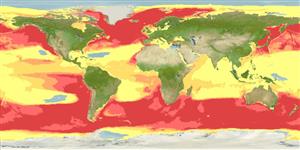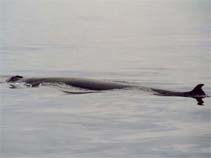Advertisement
Balaenoptera physalus (Linnaeus, 1758)
Fin whale| Native range | All suitable habitat | Point map | Year 2050 |

|
| This map was computer-generated and has not yet been reviewed. |
| Balaenoptera physalus AquaMaps Data sources: GBIF OBIS |
Sierra Leone country information
Common names:
[No common name]
Occurrence: native
Salinity: marine
Abundance: | Ref:
Importance: | Ref:
Aquaculture: never/rarely | Ref:
Regulations: no regulations | Ref:
Uses: no uses
Comments:
National Checklist:
Country Information: https://www.cia.gov/library/publications/resources/the-world-factbook/geos/sl.html
National Fisheries Authority:
Occurrences: Occurrences Point map
Main Ref: Jefferson, T.A., S. Leatherwood and M.A. Webber, 1993
National Database:
Occurrence: native
Salinity: marine
Abundance: | Ref:
Importance: | Ref:
Aquaculture: never/rarely | Ref:
Regulations: no regulations | Ref:
Uses: no uses
Comments:
National Checklist:
Country Information: https://www.cia.gov/library/publications/resources/the-world-factbook/geos/sl.html
National Fisheries Authority:
Occurrences: Occurrences Point map
Main Ref: Jefferson, T.A., S. Leatherwood and M.A. Webber, 1993
National Database:
Common names from other countries
Classification / Names Κοινά ονόματα | Συνώνυμα | Catalog of Fishes (gen., sp.) | ITIS | CoL | WoRMS
Environment: milieu / climate zone / depth range / distribution range Οικολογία
Πελαγικό(ά); ωκεανόδρομο(ς) (Αναφ. 75906); εύρος βάθους 0 - 230 m (Αναφ. 1005). Tropical; 90°N - 90°S, 180°W - 180°E
Distribution Χώρες | Περιοχές FAO | Οικοσυστήματα | Παρουσίες | Εισαγωγές
Circumglobal except the Arctic: Balaenoptera physalus physalus: Svalbard, Barents Sea, North Carolina, Portugal, Cantabrian Sea, Newfoundland, Gulf of Mexico, Greater Antilles, Faroe Islands, Norway, Canary Islands, Sea of Okhotsk, Kuril Islands, Bering Sea, Chukchi Sea, Gulf of Alaska, Sea of Japan, Japan, Taiwan, Ogasawara, Hawaii, California, Baja California, Gulf of California; Balaenoptera physalus quoyi: Ross Ice Shelf, Brazil, Gabon, Angola, Namibia, South Africa, Madagascar, Western Australia, New Zealand, Colombia, Peru, Chile (Ref. 1522).
Length at first maturity / Μέγεθος / Weight / Age
Maturity: Lm ? range ? - ? cm Max length : 2,700 cm TL αρσενικό/απροσδιόριστο; (Αναφ. 1394); μεγ. δημοσιευμένο βάρος: 75.0 t (Αναφ. 1394)
The largest of the fin whales. Seen near shore, most commonly where deep water approaches the coast. Feeds on small invertebrates, schooling fishes, and squid. They are active lunge feeders (Ref. 1394). They are preyed upon by great white sharks (Ref. 32140). Following depletion of blue whale stocks, whalers shifted their attention to fin whales. Populations everywhere were substantially reduced. At present the worldwide population does not seem to appear in any immediate danger (Ref. 1394). Minimum depth from Ref. 116169. Seen near shore, most commonly where deep water approaches the coast (Ref. 1394). Commonly in groups of 2 to 7 individuals (Ref. 801). Feeds on small I krill (Ref. 122680), invertebrates, schooling fishes, and squid. They are active lunge feeders (Refs. 1394, 122680).
Main reference
Αναφορές | Συντονιστής | Συνεργάτες
Jefferson, T.A., S. Leatherwood and M.A. Webber. 1993. (Αναφ. 1394)
IUCN Red List Status
(Αναφ. 130435: Version 2024-2)
Ευάλωτο, βλέπε Κόκκινη Λίστα (VU) (A1d); Date assessed: 04 February 2018
CITES status (Αναφ. 108899)
Appendix I: International trade banned
CMS (Αναφ. 116361)
Appendix I & II: Endangered migratory species conserved through agreements
Human uses
αλιεία: Εμπορικό(ά)
FAO - αλιεία: landings, species profile | FishSource | Η θάλασσα γύρω μας
Εργαλεία
Περισσότερες πληροφορίες
Διαδικτυακές πηγές
BHL | BOLD Systems | CISTI | DiscoverLife | FAO(αλιεία: species profile; publication : search) | GenBank (genome, nucleotide) | GloBI | Gomexsi | Google Books | Google Scholar | Google | PubMed | Δέντρο Ζωής | Wikipedia (Go, αναζήτηση) | Zoological Record
Estimates based on models
Preferred temperature
(Ref. 115969): 0.2 - 4.6, mean 1.5 (based on 25596 cells).
Ελαστικότητα
(Αναφ. 69278)
Μεσαίο(α), ελάχιστος χρόνος για διπλασιασμό πληθυσμού 1,4 - 4,4 έτη (K=0.25-0.27; tm=17.5).
Price category
(Αναφ. 80766):
Unknown.




